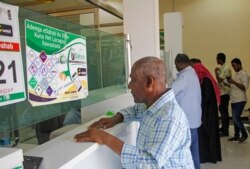Stay-at-home quarantines and the temporary shutdown of some banks and establishments that provide money transfers are hindering how immigrants can send money back to their home countries, according to a special report by the World Bank.
As a result, global remittances are projected to plunge by 20% in 2020.
The report said the COVID-19 pandemic has impaired migrants’ income, which affects remittance flows.
World Bank Group President David Malpass said in a statement that remittances are a vital source of income for developing countries. The bank’s recommendation is to make remittance fees small and categorize the services as “essential” to avoid families falling into severe poverty.
“Remittances help families afford food, health care and basic needs. As the World Bank Group implements fast, broad action to support countries, we are working to keep remittance channels open and safeguard the poorest communities’ access to these most basic needs,” Malpass said.
In 2019, low- and middle-income countries, also known as developing countries, received $554 billion in remittance flows. In about 66 of those countries, remittances represented more than 5% of their gross domestic product (GDP). In places such as Haiti, Honduras and Nepal, remittances accounted for more than 20% of GDP.
Cross-border money transfers
For Remitly, a Seattle company that helps people send money overseas, the pandemic is quickly pushing the change to digital remittances and converting walk-in customers to digital users.
Remitly CEO Matt Oppenheimer said the company has more than 2 million customers, and remittances have been their “bread and butter” for the past nine years.
“Sending money is a big deal because we have to collect information from our customers for compliance and security reasons. And then customers fundamentally are trusting us with their hard-earned money,” Oppenheimer told VOA.
Digital cross-border money transfers often mean lower fees to users, while making the process of sending and receiving money easier than having to visit a bank branch.
Because of the pandemic, customers cannot get to the physical locations where they were sending money. However, the need for those on the receiving end is the same, if not greater, with the current health crisis, Oppenheimer added.
“We see a lot of customers shifting to use our service and other digital services, as well. And so, if you look at February to March, as an example, the number of new customers we added grew by 100%. So, it was double, and that is pretty amazing,” Oppenheimer said.
A study of mobile money remittances by GSMA, the trade association of mobile operators, found that mobile technology cuts remittance costs in half and has been processing more than $1.3 billion a day. In 2018, the mobile money industry added a record 143 million registered customers.
In 2018, remittance flows to developing countries reached a record high of $529 billion. Global remittances, which also include flows to high-income countries, reached $689 billion, up from $633 billion in 2017.
After the 20% decline in 2020, the World Bank estimates that in 2021, remittances to developing countries will recover and rise by 5.6% to $470 billion. Still, the latest report shows skepticism, as it reports the full impact for remittance remains uncertain under the COVID-19 pandemic.
“In the past, remittances have been countercyclical, where workers send more money home in times of crisis and hardship back home. This time, however, the pandemic has affected all countries, creating additional uncertainties,” the report says.









